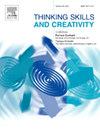Creative learning environments and mathematics self-efficacy as predictors of mathematics achievement: Insights from PISA 2022 across three countries – Korea, Canada, and Türkiye
IF 4.5
2区 教育学
Q1 Social Sciences
引用次数: 0
Abstract
This study investigates the direct and indirect relationships between creative learning environments, mathematics self-efficacy, and mathematics achievement by using the Programme for International Student Assessment (PISA) 2022 data sets from Korea, Canada, and Türkiye. The study sample consists of 6454, 23 073, and 7250 participants from Korea, Canada, and Türkiye, respectively. The structural equation model was built on the group socialization development theory and the social cognitive theory. The results for all countries reveal that creative learning environments positively and significantly affect mathematics self-efficacy. Mathematics self-efficacy, in turn, has a positive and significant effect on mathematics achievement. In each country, the direct effect of creative peers and family environment on mathematics achievement is positive, low, and significant, while the direct effect of creative school and class environment is found to be negative, low, and significant. Furthermore, creative learning environments indirectly contribute to mathematics achievement through mathematics self-efficacy. Creative learning environments directly predict mathematics self-efficacy at a moderate level, whereas they indirectly predict mathematics achievement at a low level. Mathematics self-efficacy consistently emerges as a moderate predictor of mathematics achievement across all three countries, and it plays a partial mediating role in the relationship between creative learning environments and mathematics achievement.
创造性学习环境和数学自我效能作为数学成绩的预测因素:来自韩国、加拿大和土耳其三国的PISA 2022的见解
本研究通过使用来自韩国、加拿大和土耳其的国际学生评估项目(PISA) 2022数据集,调查了创造性学习环境、数学自我效能感和数学成绩之间的直接和间接关系。研究样本分别由来自韩国、加拿大和日本的6454人、23 073人和7250人组成。结构方程模型是在群体社会化发展理论和社会认知理论的基础上建立的。结果表明,创造性学习环境对数学自我效能感有显著的正向影响。数学自我效能感对数学成绩有显著的正向影响。在每个国家,创造性同伴和家庭环境对数学成绩的直接影响是积极的,低的,显著的,而创造性学校和班级环境的直接影响是消极的,低的,显著的。此外,创造性学习环境通过数学自我效能间接促进数学成绩。创造性学习环境在中等水平上直接预测数学自我效能感,而在低水平上间接预测数学成绩。数学自我效能感在三个国家的数学成绩中均表现为中等预测因子,并在创造性学习环境与数学成绩之间的关系中起部分中介作用。
本文章由计算机程序翻译,如有差异,请以英文原文为准。
求助全文
约1分钟内获得全文
求助全文
来源期刊

Thinking Skills and Creativity
EDUCATION & EDUCATIONAL RESEARCH-
CiteScore
6.40
自引率
16.20%
发文量
172
审稿时长
76 days
期刊介绍:
Thinking Skills and Creativity is a new journal providing a peer-reviewed forum for communication and debate for the community of researchers interested in teaching for thinking and creativity. Papers may represent a variety of theoretical perspectives and methodological approaches and may relate to any age level in a diversity of settings: formal and informal, education and work-based.
 求助内容:
求助内容: 应助结果提醒方式:
应助结果提醒方式:


